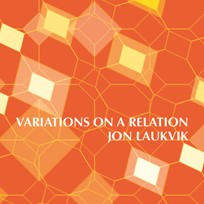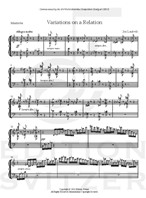
Variation on a Relation
Composer: Jon Laukvik
Instrument: Marimba and Piano
Level: Advanced
Published: 2012
Price: €25.00
Item details
-
Description +
-
Duration: 9 min.
This set of eight variations is not based on a musical theme, as is usually the case. The basis for the composition is rather the relationship between both instruments as well as their players. The instruments have some facets in common but are nevertheless very different.
Sometimes the two instruments work against each other, as in variation 1, or together, as in variation 6. The humour in the relationship becomes evident in variation 2 and especially in variation 7. On the other hand, light aggression appears in variation 4; in variation 6 the aggression is clearer. Variation 3 is characterized by a long period of relaxed contentment.
The piece was commissioned by the 6th World Marimba Competition Stuttgart in 2012 and was played in the second round of the competition. I thank Klaus Treßelt and Marta Klimasara cordially for the commission and for their affectionate help during the composing process. I also thank the publisher Johan Svitzer for his highly professional and always motivating engagement with this edition.
Some comments concerning the interpretation:
Variation 1: very fast tempo! Loud at the outset, then continuous decrescendo until bar 16, subsequently gradual crescendo until bar 30. The piano sixteenths rather sparkling and brilliant; no pedal.
Variation 2: mumbling tremolo. No accents at the beginning of the bar starting from bar 32 onwards. Sixteenth quintuplets as small protuberances. Staccato melody notes a little sharp. Variation 3: very simple and calm, but also very espressivo.
Variation 4: fast tempo, very accurate rhythm, the sixteenths even and fast. Definite accents, crescendi a little aggressive. Bar 112 without any ritardando!
Variation 5: very sonorous in spite of the restrained dynamics. The melody wanders between the top voices of the marimba and the piano. Delicate crescendi and decrescendi. Total harmony.
Variation 6: end of the total harmony. Extremely accurate rhythm! The sound a little aggressive. Marimba: hard tones; Piano: very dry chords, no pedal. Observe the three dynamic indications:
ff, mf, fff.
Variation 7: a kind of pas de deux, like a coquettish scherzo that also contains some aggression. To be played with humour and in a somewhat theatrical attitude. In the double glissandi, only the interval at the beginning and the end are important. If there is an interval of the third at the beginning, there could be seconds or fourths within the glissando. Glissandi on the black keys are not typical for marimba; but when they are played rather softly, they should not be a big problem.
Variation 8: Finale in the shape of a rondo. As „couplets“ quotations from earlier variations appear. The rondo itself should be virtuosic.
-
-
Instrumentation +
-
Marimba and Piano
-
-
About the composer +
-
Jon Laukvik was born in 1952 and received his earliest music training as organist and pianist in his native town Oslo. He went on to study organ at the University of Music in Cologne with Michael Schneider and harpsichord with Hugo Ruf. He also studied organ privately with Marie-Claire Alain in Paris.
From 1980 till 2016, he was professor at the University of Music and Performing Arts Stuttgart. Since 2001 he is also professor at the Norwegian Academy of Music in Oslo. He is also a visiting professor at the Royal Academy of Music, London.
Jon Laukvik has toured throughout Europe, Canada, Japan, Korea, Israel and the United States. He is frequently in demand to serve on competition juries and to teach seminars and masterclasses.
He is author of a highly successful organ tutor Historical Performance Practice in Organ Playing in three volumes, published by Carus-Verlag.
He has edited the Handel Organ Concerti Op. 7 for Carus-Verlag (together with Werner Jacob). A complete edition of the organ works of Louis Vierne in 13 volumes (edited together with David Sanger) was published by Carus-Verlag in 2008.
His compositions include works for solo organ, organ with other instruments (i.e. piano, percussion, trumpet, trombone, cello, horn) as well as vocal and instrumental works.
-
-
Reviews +
-
Review (Percussive Notes, May 2013)
European composer Jon Laukvik’s catalog includes compositions for solo organ and organ with other instruments, as well as vocal and instrumental works. Regarding “Variations on a Relation” (for marimba and piano), Laukvik writes in his prefatory notes: “This set of eight variations is not based on a musical theme, as is usually the case. The basis for the composition is rather the relationship between both instruments as well as their players. The instruments have facets in common but are nevertheless very different.”
Since there is no traditional introductory thematic section, the continuous eight variations commence at the outset with the piano articulating a driving, two-octave unison melodic passage in 4/4 with continuous sixteenth notes. The marimba initially has static four-note harmonies that work with the piano to provide harmonic insight and syncopated rhythmic accompaniment in a forceful, punctuated dialogue. This first variation concludes with the roles being reversed as it leads into the second variation.
The second variation is a total contrast to the opening 30 measures with piano tremolos in the lowest register echoed by reflectively pensive arpeggiated figures (quintuplets) in the marimba. Each of the following variations provide an accessible unique tonal twist, with the fourth, sixth, and eighth variations being the most challenging musically, primarily because of the fast tempo markings and the continual changing and inclusion of mixed meters (3/16, 4/16, 5/16).
This 280-measure composition was commissioned by the 6th World Marimba Competition in Stuttgart (2012) by Klaus Treßelt and Marta Klimasara, and it will require not only an advanced marimbist but an equally skilled (if not more advanced) pianist to provide a satisfying duo music experience.
—Jim Lambert
-
-
Credits +
-
Front cover graphics and layout: Sune Kliborg Lynge (Kliborg Design)
Photo: Susanne Gräfin Adelmann (www.graefin-adelmann.com) Translation (chinese): Jonathan Yeung
Printed in Copenhagen, Denmark
Copyright © Edition SVITZER
Special thanks to Ivana Bilić
Engraving: Johan Svitzer
www.editionsvitzer.com
-










